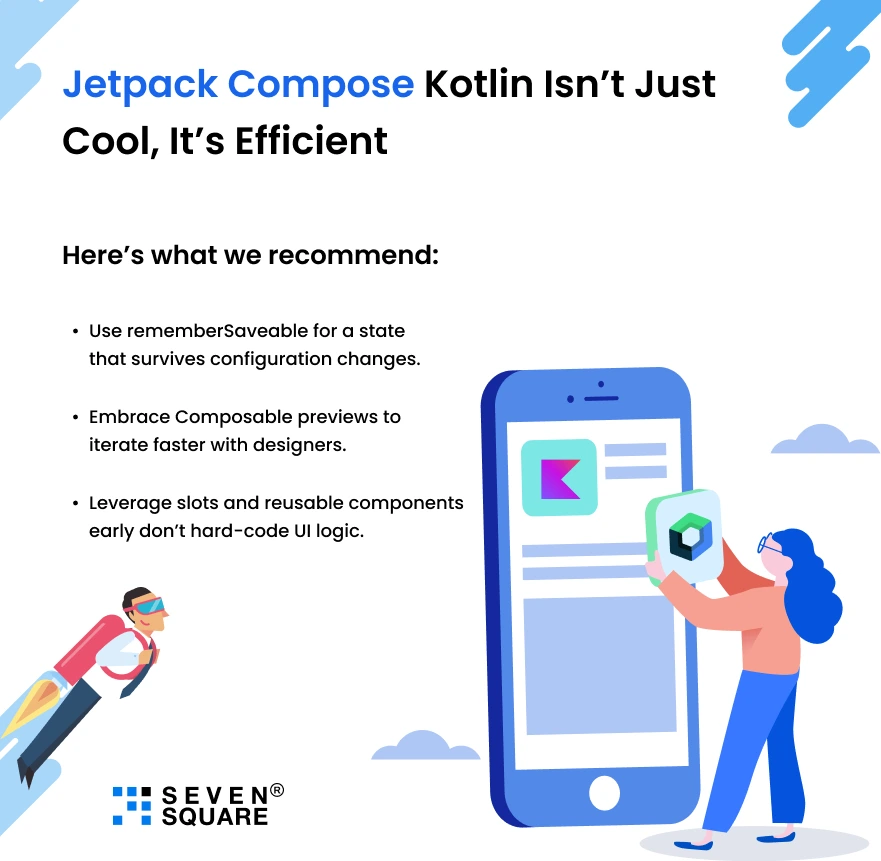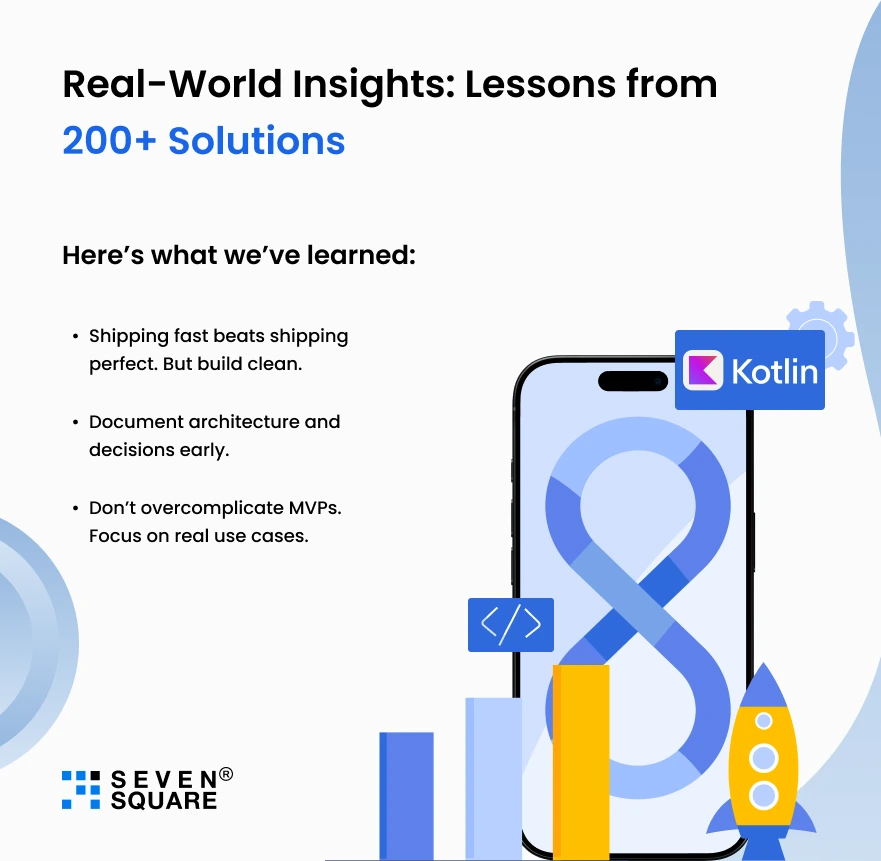Imagine this: You’re three sprints into building your Android app. The UI looks slick, the basic features work, and the deadline’s around the corner.
But now, performance starts dipping, coroutine misfires are cropping up, and your team’s spending hours debugging what should’ve been simple flows.
Sound familiar?
At Seven Square, we’ve seen this pattern countless times. Founders come to us after burning time and money on avoidable mistakes usually because the app wasn’t built with Kotlin’s full potential in mind.
With years of experience in mobile app development, and 200+ custom solutions under our belt, we’ve learned that knowing the right Kotlin tricks early can make or break your product’s success.
Here’s what you’ll wish you knew before building your Android app in 2025 plus some hard-earned Kotlin tips for Android that we live by.
Kotlin Coroutines Are Powerful: If You Use Them Right
You’ve heard it before: coroutines simplify async programming. But what they don’t tell you is how easy it is to misuse them.
Launching coroutines on the wrong scope, or leaking jobs without cancellation strategies, can destroy your app’s performance.
Our tip:
- Use viewModelScope for UI-related coroutines.
- For background tasks, use Dispatchers.IO smartly and don’t throw everything there.
- Handle exceptions with CoroutineExceptionHandler.
In 2025, knowing Kotlin coroutine best practices isn’t optional. It’s the foundation of scalable Android architecture.
Jetpack Compose Kotlin Isn’t Just Cool, It’s Efficient

Many teams still treat Compose like a shiny add-on. But when used right, it radically improves speed, scalability, and design implementation.
Here’s what we recommend:
- Use rememberSaveable for a state that survives configuration changes.
- Embrace Composable previews to iterate faster with designers.
- Leverage slots and reusable components early don’t hard-code UI logic.
If you’re still mixing XML with Compose, it’s time to commit. Jetpack Compose Kotlin is where the future of Android is heading.
Avoid the Kotlin vs Java Android Debate: Kotlin Wins, Hands Down
Yes, Java’s been around forever. But if you’re building a new Android app in 2025, there’s no reason to go with anything but Kotlin.
Choose Kotlin for Android app development because it is null-safe, and officially backed by Google.
What Kotlin gives you:
- Extension functions = cleaner code.
- Data classes = fewer bugs.
- Sealed classes + when expressions = elegant state handling.
The real difference? Velocity. Kotlin Android development speeds up your dev cycles without compromising maintainability.
Architecture Matters: Keep It Clean & Testable
No matter how cool your UI is, a messy architecture will tank your app post-launch. Use Kotlin to build modular, testable systems.
Our stack suggestion:
- MVVM + Hilt + Navigation Component
- Repository pattern for clean data flow
- StateFlow and SharedFlow for reactive updates
Solid Kotlin Android architecture keeps your team sane and your app easy to scale.
Productivity Hacks Inside Android Studio
You don’t need a 10x developer. You need devs who know how to get more done in less time. That’s where Kotlin Android Studio productivity hacks come in.
Try this:
- Use Live Templates for repetitive boilerplate.
- Enable Power Save Mode when debugging battery-heavy flows.
- Run Lint and Code Analyzer before every release.
Start with the Right Kotlin Tips for Android
Before you write a single line of code, get your fundamentals straight:
- Use const val instead of val for compile-time constants.
- Prefer to apply {} for object configuration.
- Use sealed class for API state results (loading, success, error).
These Kotlin best practices help avoid tech debt and future rewrites
Jetpack + Kotlin = Speed & Stability
The Android ecosystem is evolving fast. Jetpack libraries are optimized for Kotlin and they help ship robust apps faster.
Must-use Jetpack components:
- Room for local storage
- WorkManager for background tasks
- Paging3 for infinite scrolls
Used with coroutines and LiveData/Flow, this stack keeps your app smooth under load.
Thinking Cross-Platform? Consider Kotlin Multiplatform
Building both Android and iOS apps? Kotlin Multiplatform (KMP) lets you share logic between platforms without a bloated codebase.
Best use cases:
- Shared business logic (validation, data models)
- Networking + API layer
- Analytics & tracking
KMP is still maturing, but if cross-platform’s on your radar, it’s worth exploring in 2025.
Real-World Insights: Lessons from 200+ Solutions

At Seven Square, we’ve helped startups, eCommerce platforms, and fintech ventures launch apps that don’t just work but they scale.
Here’s what we’ve learned:
- Shipping fast beats shipping perfect. But build clean.
- Document architecture and decisions early.
- Don’t overcomplicate MVPs. Focus on real use cases.
Our team of 50+ engineers and product thinkers isn’t here to impress but we’re here to deliver tech that works.
Why Flutter Might Be Worth a Look?
Not sure if Kotlin’s the right fit? Considering cross-platform with Flutter?
Go through our Hire Flutter Developers page. Whether it’s Kotlin or Flutter, we help you pick the right tech for your vision, not the trend.
Flutter’s great for MVPs or when budget/time constraints are tight. Kotlin’s better when you need fine-grained control and deep Android integration.
Want honest advice? We’ll tell you when not to use either.
Still Wondering If Kotlin’s Right for You?
Here’s a quick checklist:
- You’re building a native Android app in 2025.
- You want scalable, maintainable code.
- You care about developer speed and performance.
If you ticked these boxes, Kotlin is your answer.
Still not sure? Talk to someone like us who’s built dozens of Kotlin apps.
Want to Build Smarter with Kotlin?
The real edge in Android app development today isn’t about choosing the “best” language. It’s about building with intent.
At Seven Square, we build products that live in the real world. And Kotlin? It helps us do that faster, cleaner, and smarter.
So before you commit to that next app sprint, pause. Review your stack. Rethink your architecture. Ask the tough questions early.
Because a few smart Kotlin tricks now can save you weeks later.
Need expert Kotlin minds on your next Android project? Let’s talk!
FAQs
- Kotlin vs Java for Android isn’t even a debate in 2025. Kotlin offers concise syntax, null safety, extension functions, coroutines, and full support for Jetpack Compose to make it the preferred choice for Kotlin Android app development. It allows faster iterations and safer, cleaner code.
- Yes, Jetpack Compose Kotlin works natively with Kotlin and simplifies UI development.
- It allows real-time previews, fewer files, and reusable composables.
- For modern Android apps in 2025, Compose with Kotlin is faster to build and easier to maintain than XML-based UIs.
- Enable live templates for common code snippets, use “Analyze > Inspect Code” to clean up technical debt, and apply refactor tools to improve structure.
- These Kotlin Android Studio productivity hacks reduce errors and help developers ship faster with fewer bugs.
- Start with defining clean architecture (MVVM + Jetpack), use Kotlin’s type safety and null-safety features, build with Compose for UI, and test rigorously using Kotlin-first tools like MockK and JUnit.
- This ensures smooth Kotlin Android app development from day one.